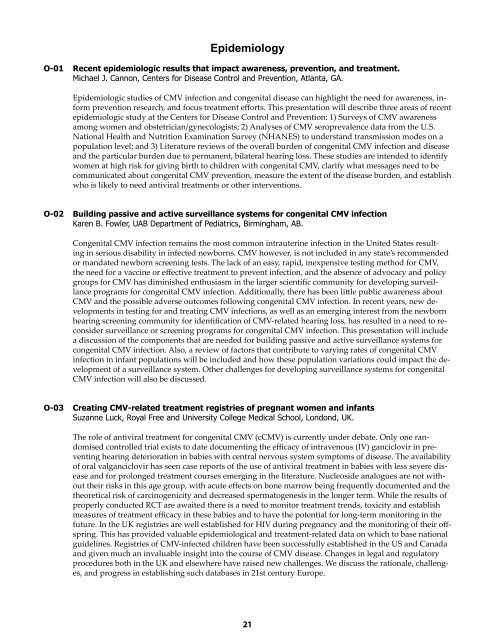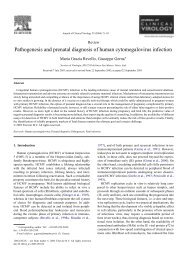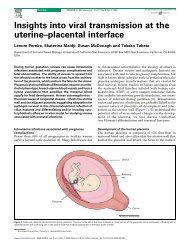Congenital Cytomegalovirus Conference - Congenital CMV ...
Congenital Cytomegalovirus Conference - Congenital CMV ...
Congenital Cytomegalovirus Conference - Congenital CMV ...
Create successful ePaper yourself
Turn your PDF publications into a flip-book with our unique Google optimized e-Paper software.
Epidemiology<br />
O-01 Recent epidemiologic results that impact awareness, prevention, and treatment.<br />
Michael J. Cannon, Centers for Disease Control and Prevention, Atlanta, GA.<br />
Epidemiologic studies of <strong>CMV</strong> infection and congenital disease can highlight the need for awareness, inform<br />
prevention research, and focus treatment efforts. This presentation will describe three areas of recent<br />
epidemiologic study at the Centers for Disease Control and Prevention: 1) Surveys of <strong>CMV</strong> awareness<br />
among women and obstetrician/gynecologists; 2) Analyses of <strong>CMV</strong> seroprevalence data from the U.S.<br />
National Health and Nutrition Examination Survey (NHANES) to understand transmission modes on a<br />
population level; and 3) Literature reviews of the overall burden of congenital <strong>CMV</strong> infection and disease<br />
and the particular burden due to permanent, bilateral hearing loss. These studies are intended to identify<br />
women at high risk for giving birth to children with congenital <strong>CMV</strong>, clarify what messages need to be<br />
communicated about congenital <strong>CMV</strong> prevention, measure the extent of the disease burden, and establish<br />
who is likely to need antiviral treatments or other interventions.<br />
O-02 Building passive and active surveillance systems for congenital <strong>CMV</strong> infection<br />
Karen B. Fowler, UAB Department of Pediatrics, Birmingham, AB.<br />
<strong>Congenital</strong> <strong>CMV</strong> infection remains the most common intrauterine infection in the United States resulting<br />
in serious disability in infected newborns. <strong>CMV</strong> however, is not included in any state’s recommended<br />
or mandated newborn screening tests. The lack of an easy, rapid, inexpensive testing method for <strong>CMV</strong>,<br />
the need for a vaccine or effective treatment to prevent infection, and the absence of advocacy and policy<br />
groups for <strong>CMV</strong> has diminished enthusiasm in the larger scientific community for developing surveillance<br />
programs for congenital <strong>CMV</strong> infection. Additionally, there has been little public awareness about<br />
<strong>CMV</strong> and the possible adverse outcomes following congenital <strong>CMV</strong> infection. In recent years, new developments<br />
in testing for and treating <strong>CMV</strong> infections, as well as an emerging interest from the newborn<br />
hearing screening community for identification of <strong>CMV</strong>-related hearing loss, has resulted in a need to reconsider<br />
surveillance or screening programs for congenital <strong>CMV</strong> infection. This presentation will include<br />
a discussion of the components that are needed for building passive and active surveillance systems for<br />
congenital <strong>CMV</strong> infection. Also, a review of factors that contribute to varying rates of congenital <strong>CMV</strong><br />
infection in infant populations will be included and how these population variations could impact the development<br />
of a surveillance system. Other challenges for developing surveillance systems for congenital<br />
<strong>CMV</strong> infection will also be discussed.<br />
O-03 Creating <strong>CMV</strong>-related treatment registries of pregnant women and infants<br />
Suzanne Luck, Royal Free and University College Medical School, Londond, UK.<br />
The role of antiviral treatment for congenital <strong>CMV</strong> (c<strong>CMV</strong>) is currently under debate. Only one randomised<br />
controlled trial exists to date documenting the efficacy of intravenous (IV) ganciclovir in preventing<br />
hearing deterioration in babies with central nervous system symptoms of disease. The availability<br />
of oral valganciclovir has seen case reports of the use of antiviral treatment in babies with less severe disease<br />
and for prolonged treatment courses emerging in the literature. Nucleoside analogues are not without<br />
their risks in this age group, with acute effects on bone marrow being frequently documented and the<br />
theoretical risk of carcinogenicity and decreased spermatogenesis in the longer term. While the results of<br />
properly conducted RCT are awaited there is a need to monitor treatment trends, toxicity and establish<br />
measures of treatment efficacy in these babies and to have the potential for long-term monitoring in the<br />
future. In the UK registries are well established for HIV during pregnancy and the monitoring of their offspring.<br />
This has provided valuable epidemiological and treatment-related data on which to base national<br />
guidelines. Registries of <strong>CMV</strong>-infected children have been successfully established in the US and Canada<br />
and given much an invaluable insight into the course of <strong>CMV</strong> disease. Changes in legal and regulatory<br />
procedures both in the UK and elsewhere have raised new challenges. We discuss the rationale, challenges,<br />
and progress in establishing such databases in 21st century Europe.<br />
21





